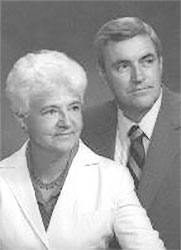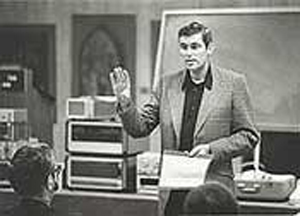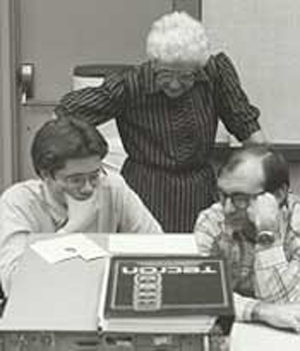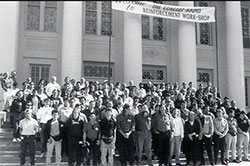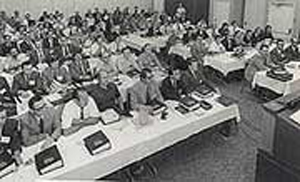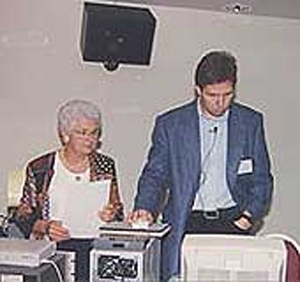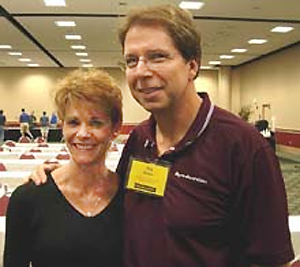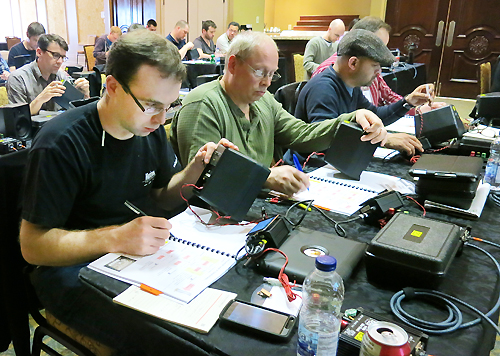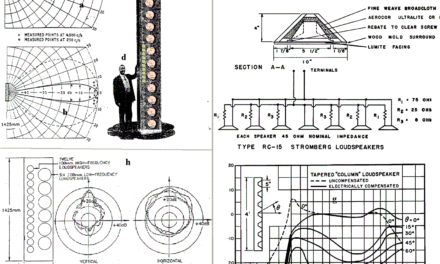by Keith Clark
Editor’s note: This interview was conducted in the early 2000s.
When noting the contributions of Don and Carolyn Davis to the professional audio industry, it’s hard to know where to even start. Their book, Sound System Engineering, originally published in 1973 (and since updated), remains a standard audio and systems resource.
Founders of SynAudCon, Don and Carolyn established the industry’s pre-imminent and most respected (and independent) educational resource, teaching thousands the essential concepts of audio and acoustics that in turn has led to remarkable advancements in systems and sound quality that we all enjoy. Now consider that these accomplishments just scratch the surface of their crucial role in leading the industry to its current modern era…
I had the privilege of spending an afternoon with Don and Carolyn while attending a SynAudCon seminar and workshop in southern Indiana. They were gracious enough to travel to meet me, with the warm and at times reverential reception they received from attendees standing as a testament to the tremendous respect they’ve tirelessly earned in service. Our conversation was fascinating, spanning a wide range of topics and touching on crucial historical landmarks that lend perspective and understanding to the current state of the industry.
Now “retired,” they continue to travel extensively, staying in touch with an ever-growing network of friends and exploring new places. Like many long-married couples, they have the endearing trait of often finishing each other’s sentences or interrupting to take the conversation in new directions. Frankly, I didn’t have to interject much as the two shared the fascinating tale of their lives in pro audio. So without further adieu, let’s roll tape and simply say, “go”.
Keith Clark: Don, I understand you worked with Altec Lansing prior to the founding of SynAudCon.
Don: I worked with Altec from 1959 through the early ‘70s, marketing and, really, managing mostly. I was a field rep based in Chicago serving a big chunk of the Midwestern U.S. We weren’t exactly sales reps, but more comprehensive in scope. Prior to this point, Altec Lansing products were distributed through Graybar, and major installations were often headed up by the Altec Service Company, the theater service division.
Just at the time I joined the company, they decided to set up their own distribution with sound contractors. A guy named Mo Morris had seen the vision that sound contracting was a viable thing, that it was a good way to move inventory out of the factory and into the warehouses of the contractors, and that it was a good way to respond quicker to needs.
So my job was to go out and identify potential contractors, and then to set them up as dealers and make sure they were supported, providing any encouragement possible.
This led to doing a little bit of everything. I enjoyed this role a great deal, and in the process, I worked with some of the “old-time” guys who had been Western Electric contractors. They were superbly trained people and quite used to top-of-the-line equipment – a piece of Western Electric equipment cost more than anything else, yet they invariably got all the better jobs.
Nate Reese in Detroit is a good example of this. It was said that during his first couple of years in business, he lost almost every job he bid on. But then he followed up with these same customers a bit later, knowing that most would be unhappy. He’d say ‘hello, I’m Nate Reese and I was high bidder on your project. Are you happy with the work?’ And, of course he got most of them on board as permanent customers.
After a while he didn’t really have to be too involved with the bidding process, because if they wanted it done right, they came to him. Nate was probably the first guy to make himself a millionaire in audio. It was his integrity, and that of Western’s gear, that did it.
So in the background was Western Electric, and you went out and tried to find people that fit that mold. When Altec was formed after the dissolution of Western Electric in the late 1930s, a lot of the Western personnel came on board. They bought up the rights to the best Western products for pennies on the dollar and then proceeded to make themselves wealthy men.
KC: You were one of the pioneers of equalization…
Don: At Altec, I constructed a seminar program in 1968 to show people how to equalize systems. The initial problem was that while even the early equalizers worked very well, the systems in general didn’t. People put in EQs and discovered they hadn’t planned enough power, for example, because now they could raise the levels. And what had been adequate before in feedback constraints wasn’t even close to adequate any more. A 10 dB increase in acoustic gain meant a 10 dB increase in power.
This emphasis in training people for equalization is exactly what Pat (Brown) is doing here with SynAudCon. You’ve got to look at polarity, you’ve got to signal align, you’ve got to clean up all of the impedances, match all the levels, and so on.
The way I found out about the problems, initially, was that we had franchised a bunch of contractors to handle equalization, and they had to spend about $10,000 on specialized equipment – GenRad and Hewlett Packard test gear. But nothing good in the way of progress and improvement seemed to be happening, so Carolyn and I loaded the first HP Real-Time Analyzer (RTA) ever made into the trunk of our car –
Carolyn: – Don had talked HP into building the RTA for him, the first one ever –
Don: – and we went on the road to find out what was going on. We quickly saw that even the best contractors were building inadequate systems – not that they weren’t great compared to most others, but they still weren’t adequate in terms of the extra power that could and should be delivered.
We learned to look at a space and to understand that what it presented acoustically was the challenge. Fit and match the space with an array that could meet the criteria of the space, and then work backwards through the system to fill it out with power and other components needed to do the job right. At that point, system design was being done just the opposite, from the microphone out, rather than speakers back.
Carolyn: And you should mention at that time that HP had also just introduced the desktop computer –
Don: – and that was a huge help.
Carolyn: Yes, Don bought into it quickly.
Don: I was looking at all the “gimmicks” of the time. But in this case, specifically, I was always lousy with a slide rule anyway, and the ability to be able to program everything on this portable computer was great. These early computers were really nothing more than a big programmable calculator, but they were very helpful.
In the earliest computer, we had to go through about 2,000 steps to attain calculations. Reverberation time, noise control, acoustic gain – all of this and more was plugged in for calculation. Of course, we hadn’t discovered how to do intelligibility yet, this was still intuitive only.
A bit later, V.M.A. Peutz of Holland and some other smart people figured out that intelligibility could be designed into a system ahead of time. Peutz was a real genius, unlocking the whole intelligibility problem. While there are current “gods” of intelligibility, this is where it all came from, where it all started.
When Peutz took one of the early TEF analyzers and programmed it to measure intelligibility, essentially – everybody objects to the term “measurement” in this regard but its an estimate taken off the data, it provided a place and explanation as to why so many systems of the time were falling short. The numbers really proved it.
KC: I’ve also read that you were instrumental in bringing the first TEF analyzer to market.
Don: Cal Tech (university) came to us and asked if we’d take over the licensing of Time Delay Spectrometry. They had only one licensee at that point, after a decade, and we got them 120 or so licensees within a year. That was kind of an interesting experience, and when they said, ‘OK, now it’s going good and we want it back’, we gave it right back to them. We weren’t in the business to be wheeler-dealers.
Carolyn: Getting back to equalizers, in March of 1968, Don went to a convention and came back with this idea for equalizers. He went straight to Art Davis (an Altec engineer) and told him about it. Art wanted to do it a little differently, and Don said fine, I don’t really care, and he and Don were on the original patent.
Don: I spaced out what the filters had to do, and Art made a contribution I hadn’t thought about, to make frequencies combining, summing –
Carolyn: – and we had a prototype by September and went to the AES Convention that year and presented a paper on it.
Don: The chairman of the session had been involved in early equalization work as well, and when he read the title of the paper – “One-Third Octave Broadband Equalizer” – he kind of stopped and raised an eyebrow on the word “broadband”.
To him, what we were calling “broadband” was actually very narrow. Now, there’s nothing wrong with a filter being exactly the shape of whatever your problem is, but you can’t go after anything that isn’t the middle of the phase realm. There are things in there – “bumps” – that if you put an EQ on it, you only make the problem worse.
But if you put it in the minimum phase realm, then the EQ clears everything – it corrects amplitude, it corrects phase, it even corrects time. But it must precisely meet, and any divergence causes problems. There was a great deal to be said for a parametric equalizer, only nobody really knew how to make them at the time. Dr. Paul Boner was making these real narrow filter devices, trying to make the intrusion as minimal as possible. But one-third octave shaping filters could shape to the broadband nature of the problem beautifully, and they didn’t introduce any major phase anomalies as a result. You follow the general shape of the curve.
Now there might have been a little individual narrow-band anomaly, but these were so narrow that they were inside critical bandwidths, and thus they didn’t much matter.
Nowadays we have the correct parametric process and equipment, and there are also these beautiful programs that invoke the house curve and let you match to it. If you know what you’re doing you can get very refined equalization.
But in the meantime, one-third equalization dramatically improved loudspeakers of that time, and it also led to discovery of problems with signal alignment. This is still something no one has really pursued fully yet, at least that I’m aware of. I don’t think the equalization field and issues have been fully worked out yet.
Right now, with most of the current devices, you get further by improving the audible quality of sound systems with signal alignment than you ever do with anything else, particularly with the newer array concepts. It will always be a tough job to have more than one of anything in an acoustical system – nature doesn’t like that. So, you make your compromises.
The contribution that I felt like I made is that prior to this work, the acoustic environment was almost totally ignored. Yet all along that was the major tool to play with. And in fact, most rooms ought to be corrected by people doing sound systems. There’s an optimum match for every system to every room, so that you don’t add any more power than needed for maximum intelligibility and you don’t add any more absorption than necessary for maximum control of energy. This is what a good acoustical consultant should do, but it’s surprising how many of them don’t.
KC: What are the roots of SynAudCon?
Carolyn: By 1972, we could see that things at Altec were not going so well due to some management problems. About that time, Don was asked to establish the European market for them, and he said we’d go over and check things out before agreeing to do it. But at that time, the economy was under some dramatic changes and it just wasn’t feasible –
Don: – well, we had an acquaintance named Mr. Vorwig who had been in charge of truck production during the war (World War II), on the German side, and who also had been the engineer that originally tested the Volkswagen for Hitler. Mr. Vorwig had a party that we attended, and he and some of the guests, including a banker in Frankfort, laid out for us what exactly was going to happen with the economy, the deflation of the U.S. dollar that would occur. I had to tell Altec that I wouldn’t take their offer.
Carolyn: Don and I used to work for a few years and then take time off and go to Europe and travel for months at a time – we didn’t have children so we could do that. Through the ‘50s, the economy was great, but by ’72, we found that prices were already 10 times more than in the ‘50s. And, things had changed with Altec –
Don: – when a company is being torn apart by bad management, the talent leaves first. The ones that hang in there may be great workers, but that’s not where the talent lies and where the future and insight is. There were a lot of strange contracts coming across my desk that I didn’t want to sign, and this is what happens… I’ve often sworn I was going to write a book on mismanagement with all of it I’ve seen over the years. I resigned from Altec in December 1972.
Carolyn: Altec offered Don a year’s salary if he would not go to work for the competition –
Don: – Which I had no intention of doing anyway –
Carolyn: – we took six months to write our book, Sound System Engineering, because we had an income from Altec. Sams Publishing printed it at no cost and allowed us to buy it at $10 a copy. It was loose leaf at that time, and about three years later they decided to publish it as a book. Then a few years later, we revised it.
Don: We had a lot of lovely people help us with this, just like Pat (Brown) does now with SynAudCon.
Carolyn: GenRad and HP loaned us thousands of dollars worth of equipment for our seminars.
Carolyn: In 1973, the oil crisis started and things were not good in terms of starting a business, but we decided to anyway.
Don: We set out on the road with a Dodge three-quarter ton truck and a camper shell to house all the gear, towing a trailer behind it to live in. We toured the country and taught audio.
Carolyn: Don could see that the only way we would really be able to make it in doing this tour would be to set up a sponsorship program. He went to Shure – or they came to him, I can’t recall – and they were great in terms of support. That first year, Shure, UREI and Sun Music were our first sponsors.
Don: The point is that there were several of these engineering folks and their companies who were very supportive, who understood what we had and wanted to give.
Carolyn: Another interesting and critical thing at this point in time is that Altec pretty much owned the contracting business. RCA had a service company and could still do some things at that point. And, some other names that aren’t even around anymore were the big entities. At the time, companies like Electro-Voice, Shure, JBL and so forth were really still just independent gadget makers.
What we did that was unique at the time was to put together all of the elements offered by these companies into proper systems. These pioneer sponsors of SynAudCon could provide the quality components, individually, and then that equipment could be formed into quality systems.
Don: UREI, for example, was one of the first to make the equalizer, and they were a sponsor. Emilar would make the drivers that were needed. So we “filled the chain” with sponsors so that people would know where to go to fill out an entire system. That was a piece of serendipity that worked out well for both us and the sponsors. It wasn’t really a deliberate thought-out thing, but just something that happened.
Carolyn: The next year after we started the sponsorship program, Don wanted something to bind SynAudCon “grads” together, so he started a newsletter subscription, free for one year to everyone who attended a seminar, and then renew for $25, later raised to $35.
KC: I understand you had settled in California by this time?
Don: Well, we owned property there, up in the mountains. It was a place to park the trailer and basically camp out. We’d be on the road for nine months out of the year and then go back and spend part of the winter in California.
Then in the summer, when everyone was busy putting in school systems, we’d park the trailer out at the (family) farm in Indiana. The old house hadn’t been rejuvenated at that point. We were living a gypsy life.
KC: So how long did you operate SynAudCon as a “road show” concept?
Carolyn: Well, in 1992 we were still doing classes in the U.S., Canada, Europe, Japan and Australia. We were in Japan on one of these trips when Don woke up one morning and said ‘this isn’t the way I want to spend the rest of my life’. So we canceled everything at that point. Travel had gotten old.
We had moved to the farm in 1987, so we decided to take the “old farmhouse” – built in 1883 – and fix it up so we could hold classes there for 10-12 people at a time. This allowed us to keep teaching, because we still loved that part of it. We did this through 1995.
A good consultant and/or contractor – someone who worked daily in the industry – would present the hands-on, and Don would teach the theory. Now Pat can do both the theory and the practical. Don has more of an interest in the theory, never quite as interested in the hands-on side of things.
KC: So outside of your absolute dedication, why do you think SynAudCon thrived?
Don: The fascinating thing is that in the 25 years we ran SynAudCon, we hardly had a conflict with any sponsor about anything, and almost all of them are still with SynAudCon to this day.
We always tried to have a sense of integrity about our relationships with sponsors, and this was reciprocal. One time we did have to “fire” one prominent loudspeaker company as a sponsor, because they were unfairly attacking another party and presenting grossly incorrect information. This just couldn’t stand, and we refunded their money. So we always did our best to have a sense of integrity about what we were teaching.
Carolyn: We limited sponsorships to 20 and had a waiting list, and Pat has expanded that.
Don: The point is that you’re out there trying to teach people about what’s right and wrong from a technical standpoint and they’re being told so many other things making it that much harder. We’ve had people accuse us of being prejudiced, and that’s not the case.
Carolyn: We’ve always had a special appreciation of new ideas and talent, and have so much enjoyed the promotion of that talent. So much of the ‘70s was an accumulation of a lot of information, and then in the ‘80s, all of this began to be focused into new ideas and products.
Don: We got to the stage when we could recognize talent when it wasn’t perhaps all that obvious to others –
Carolyn: – Richard C. Heyser, Peter D. Antonio, V.M.A. Peutz, Dr. Eugene Patronis, Gerald Stanley, Ed Long, Ron Wickersham, Ken Wahrenbrock – these were the people that developed the concepts that were so important to us: TEF, QRD Diffusors, %Alcons, LEDE control rooms, PZM, signal alignment, etc. They conceived the ideas. We often brought their concepts to the attention of manufacturers. I was mentioning this idea recently to a friend, and he said that the ‘80s was an outpouring of everything we had learned. But this was more on an individual basis, and now Pat and Brenda are taking the entire industry upward in the same way.
KC: How did Pat and Brenda come to take the reins?
Carolyn: Each seminar that was scheduled at the farm had a consultant or contractor to work with us. A consultant scheduled to work with us in a seminar had to cancel at the last minute due to health reasons, and we asked Pat to come in and teach on an emergency basis – Pat lives only an hour from the farm. And he was great, pretty much teaching just as he does now, explaining things so clearly and so well and feeling very comfortable in front of a group of peers.
Don: He loves it –
Carolyn: – and a little later, Janine Masten, who was with EV at the time –
Don: – sharp lady –
Carolyn: – this was in 1995, and she called to ask if Don would break his rule and go to Europe to teach for them. I was sure Don would say no, but instead he turned around said, “I’ll do it if Pat Brown comes with us.”
Don: And they said yes –
Carolyn: – and when they finished the classes, Larry Frandsen (head of Mark IV Audio Europe at the time) invited us to come back the next year. Don declined, but as he did so, Larry immediately turned to Pat. Pat accepted – which was what Don had in mind when he asked for Pat to be included in the tour.
That trip lasted about three weeks, and during that entire period I didn’t call to check in with the office, and it was such a relief. It felt like it was time for us to move on, and we asked Pat if he would take over. He talked it over with Brenda, who was a very successful nurse at the time, and she gave her support. Gradually, she worked into the business more and more and now has taken on a full partner role with Pat.
Don: Well, Brenda’s very sharp, very on top of things, understands the technical part in addition to her business talents. They also have a very spiritual side to them, that we love –
Carolyn: – they don’t talk about it much. They’re so ethical and we take a lot of pride in that.
KC: What’s the biggest difference in SynAudCon now, in comparison to what you handed off to Pat and Brenda?
Don: Pat has computerized the teaching process, has brought it the rest of the way into the digital age.
Carolyn: At a seminar or workshop, everything you see Pat doing with the computers and video screens, Don used to do with slides and overhead projectors.
Don: We have preached digital revolution for 20 years, that it would be the way to go, the way of the future. It’s interesting to look at the space race – a lot of people think all of their money was just shot to the moon, but actually a very small amount of hardware went there. The big thing to come out of it is the ideas, the outflow of technical creativity.
Don: Pat and Brenda have done another vital thing, and that is to go places where we had never gone. Mexico, South America, Jordan, India, Dubai –
Carolyn: – and he’s invited to China –
Don: – and that’s invaluable. He’s spreading the knowledge. In the late ‘50s, Carolyn and I worked at the American National Exhibition in Russia, an exchange fair between them and the U.S. We were showing audio equipment.
Recently, I was interested to read a book written by a former top KGB agent who noted the most subversive thing that ever happened between the U.S. and Soviet Union was this exchange, that it changed more things in Soviet Russia than anything else. He was kind of tongue in cheek about the subversive part, but what he was saying is true.
As the SynAudCon attitude gets around, the idea that you share the information rather than hold it close, as that philosophy gets into new places, it’s fascinating to see what comes about. SynAudCon became a society, a family really, without meaning to, based on this idea of sharing information.
Carolyn: Along these lines, the web site and what Pat does with the list serve is unbelievable, and the newsletter keeps going strong. This all goes with being a society. It’s just amazing that top professionals in this industry will gladly tell everything they know through these channels, unselfishly and for the benefit of anyone willing to learn.
Recommended Reading:
Sound System Engineering
If Bad Sound Were Fatal, Audio Would be the Leading Cause of Death

